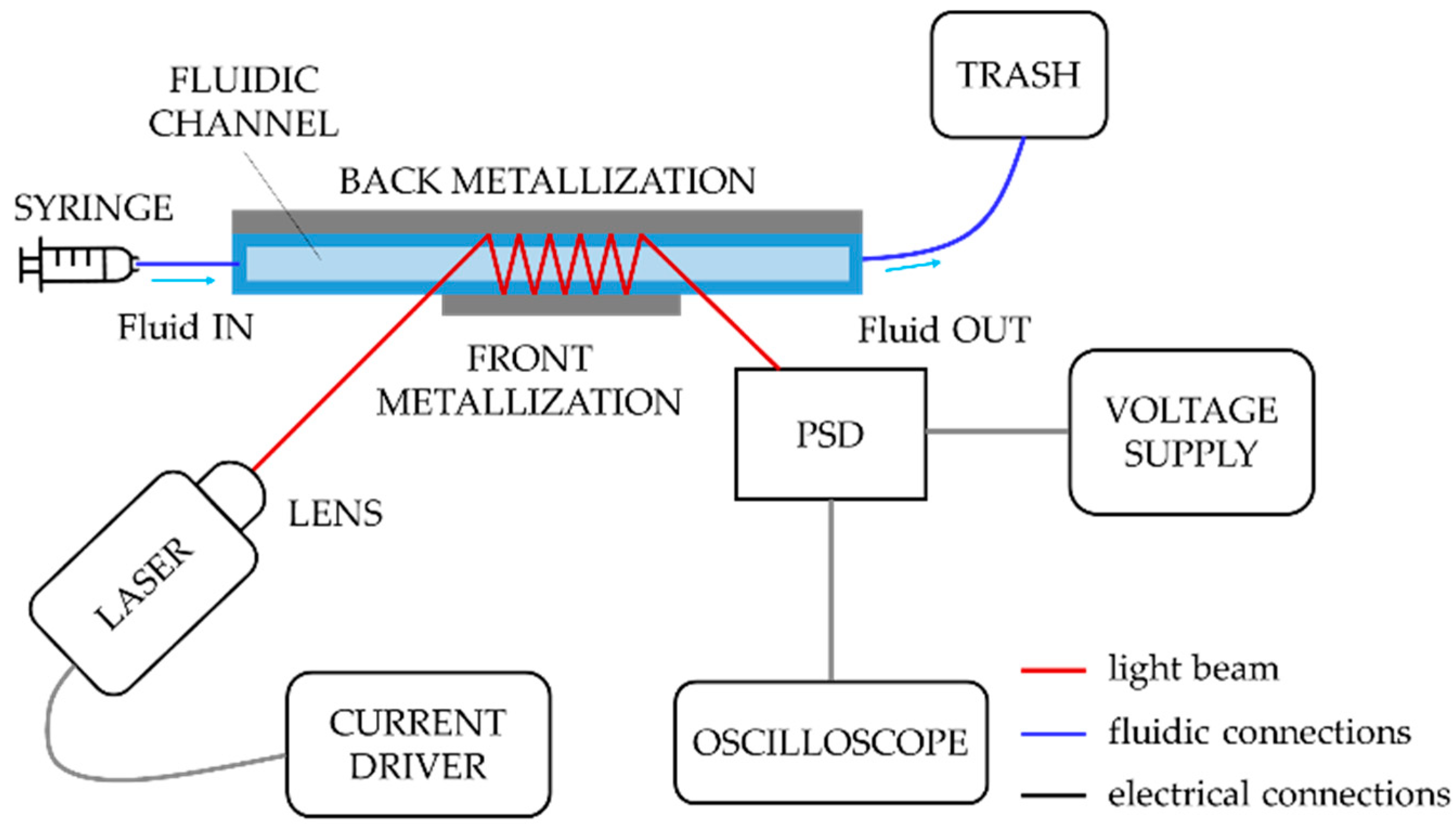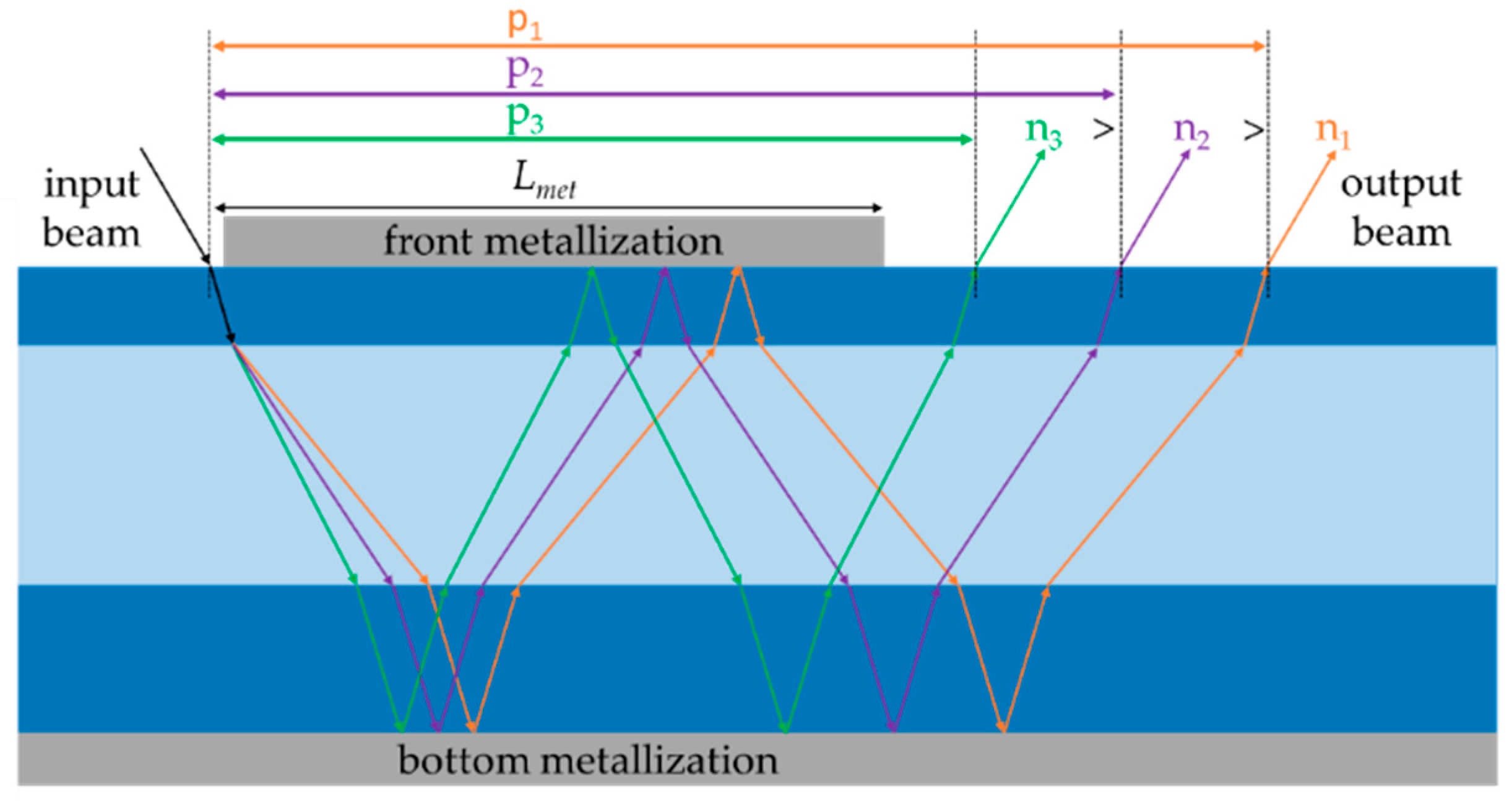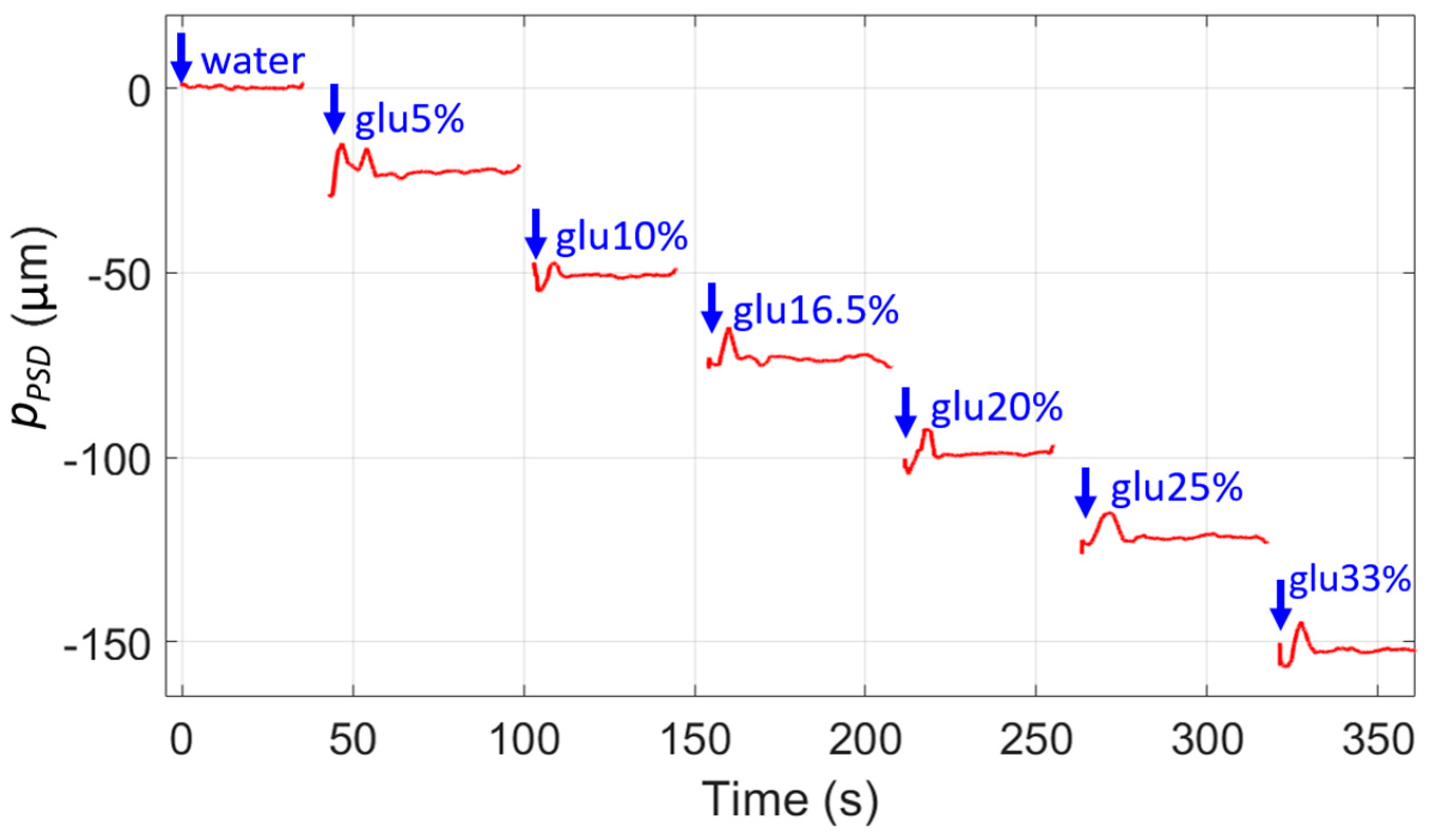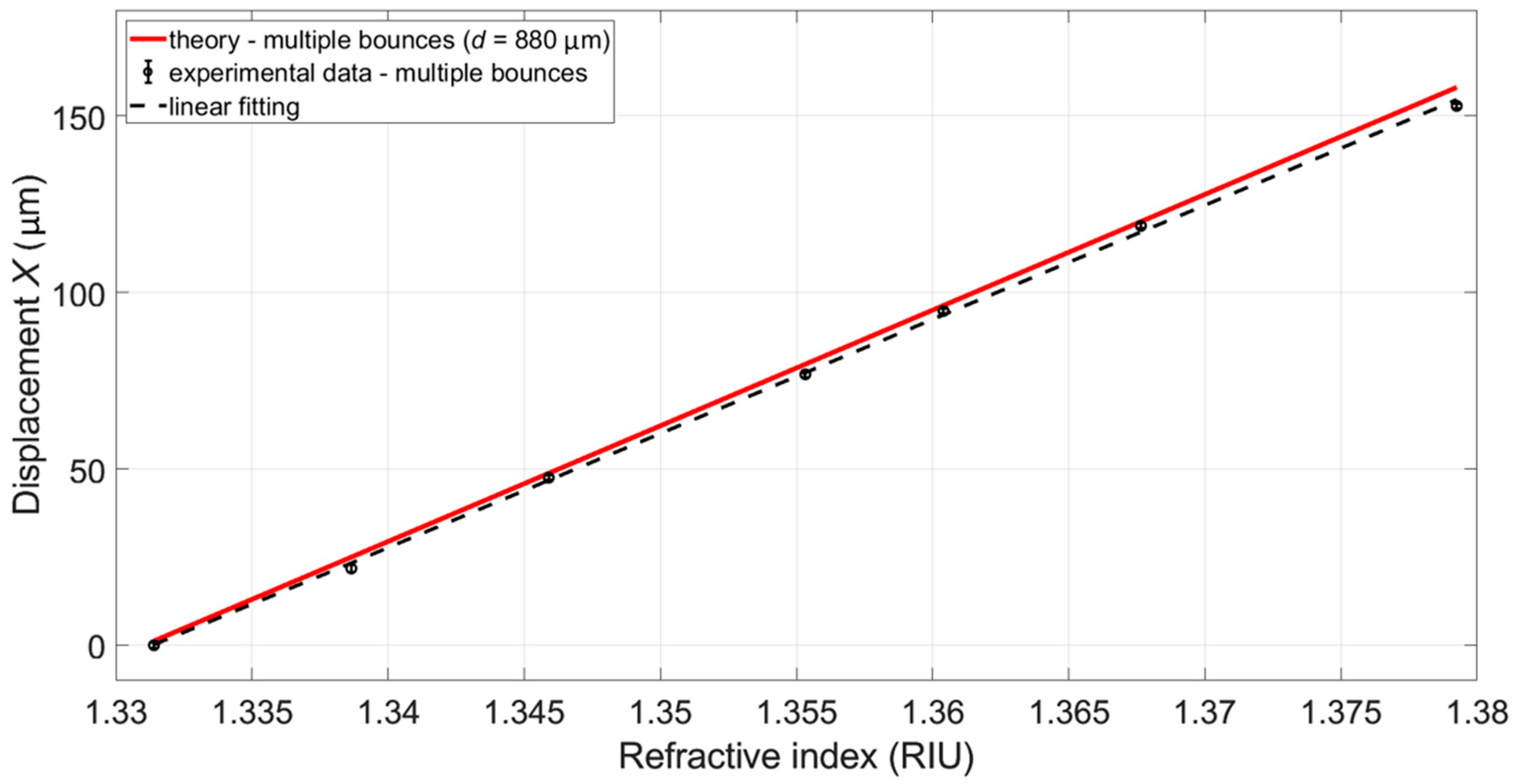Refractive Index Sensing in a Disposable Micro-Channel Provided with Integrated Reflectors Based on Laser Beam Shift †
Abstract
1. Introduction
2. Materials and Methods
2.1. Optoelectronic Instrumental Configuration
2.2. Theoretical Model
3. Results and Discussion
4. Conclusions
Author Contributions
Funding
Institutional Review Board Statement
Informed Consent Statement
Data Availability Statement
Acknowledgments
Conflicts of Interest
References
- Liu, P.Y.; Chin, L.K.; Ser, W.; Chen, H.F.; Hsieh, C.-M.; Lee, C.-H.; Sung, K.-B.; Ayi, T.C.; Yap, P.H.; Liedberg, B.; et al. Cell refractive index for cell biology and disease diagnosis: Past, present and future. Lab Chip 2016, 16, 634–644. [Google Scholar] [CrossRef]
- Seyyedmasoumian, S.; Attariabad, A.; Pourziad, A.; Bemani, M. refractive index biosensor using metamaterial perfect absorber based on graphene in near-infrared for disease diagnosis. IEEE Sens. J. 2022, 22, 14870–14877. [Google Scholar] [CrossRef]
- Eid, M.; Habib, M.; Anower, M.; Rashed, A.N.Z. Highly sensitive nonlinear photonic crystal fiber based sensor for chemical sensing applications. Microsyst. Technol. 2021, 27, 1007–1014. [Google Scholar] [CrossRef]
- Alizadeh, S.; Zareian-Jahromi, E.; Mashayekhi, V. A tunable graphene-based refractive index sensor for THz bio-sensing applications. Opt. Quantum Electron. 2022, 54, 73. [Google Scholar] [CrossRef]
- Shin, H.J.; Choi, S.W.; Ok, G. Qualitative identification of food materials by complex refractive index mapping in the terahertz range. Food Chem. 2018, 245, 282–288. [Google Scholar] [CrossRef] [PubMed]
- Belay, A.; Assefa, G. Concentration, wavelength and temperature dependent refractive index of sugar solutions and methods of determination contents of sugar in soft drink beverages using laser lights. J. Lasers Opt. Photonics 2018, 5, 1000187. [Google Scholar]
- Seki, A.; Narita, K.; Watanabe, K. Refractive index measurement in sucrose solution and beverage using surface plasmon resonance sensor based on hetero-core structured fiber optic. Procedia Chem. 2016, 20, 115–117. [Google Scholar] [CrossRef]
- Chao, K.S.; Lin, T.Y.; Yang, R.J. Two optofluidic devices for the refractive index measurement of small volume of fluids. Microfluid. Nanofluidics 2012, 12, 697–704. [Google Scholar] [CrossRef]
- Jääskeläinen, A.; Silvennoinen, R.; Peiponen, K.E.; Räty, J. On measurement of complex refractive index of liquids by diffractive element-based sensor. Opt. Commun. 2000, 178, 53–57. [Google Scholar] [CrossRef]
- Jiménez, F.; Vázquez, J.; Sánchez-Rojas, J.L.; Barrajón, N.; Úbeda, J. Multi-purpose optoelectronic instrument for monitoring the alcoholic fermentation of wine. In Proceedings of the SENSORS, Limerick, Ireland, 28–31 October 2011. [Google Scholar]
- Nemoto, S. Measurement of the refractive index of liquid using laser beam displacement. Appl. Opt. 1992, 31, 6690–6694. [Google Scholar] [CrossRef] [PubMed]




Publisher’s Note: MDPI stays neutral with regard to jurisdictional claims in published maps and institutional affiliations. |
© 2022 by the authors. Licensee MDPI, Basel, Switzerland. This article is an open access article distributed under the terms and conditions of the Creative Commons Attribution (CC BY) license (https://creativecommons.org/licenses/by/4.0/).
Share and Cite
Bodo, E.; Bello, V. Refractive Index Sensing in a Disposable Micro-Channel Provided with Integrated Reflectors Based on Laser Beam Shift. Eng. Proc. 2022, 27, 49. https://doi.org/10.3390/ecsa-9-13195
Bodo E, Bello V. Refractive Index Sensing in a Disposable Micro-Channel Provided with Integrated Reflectors Based on Laser Beam Shift. Engineering Proceedings. 2022; 27(1):49. https://doi.org/10.3390/ecsa-9-13195
Chicago/Turabian StyleBodo, Elisabetta, and Valentina Bello. 2022. "Refractive Index Sensing in a Disposable Micro-Channel Provided with Integrated Reflectors Based on Laser Beam Shift" Engineering Proceedings 27, no. 1: 49. https://doi.org/10.3390/ecsa-9-13195
APA StyleBodo, E., & Bello, V. (2022). Refractive Index Sensing in a Disposable Micro-Channel Provided with Integrated Reflectors Based on Laser Beam Shift. Engineering Proceedings, 27(1), 49. https://doi.org/10.3390/ecsa-9-13195






